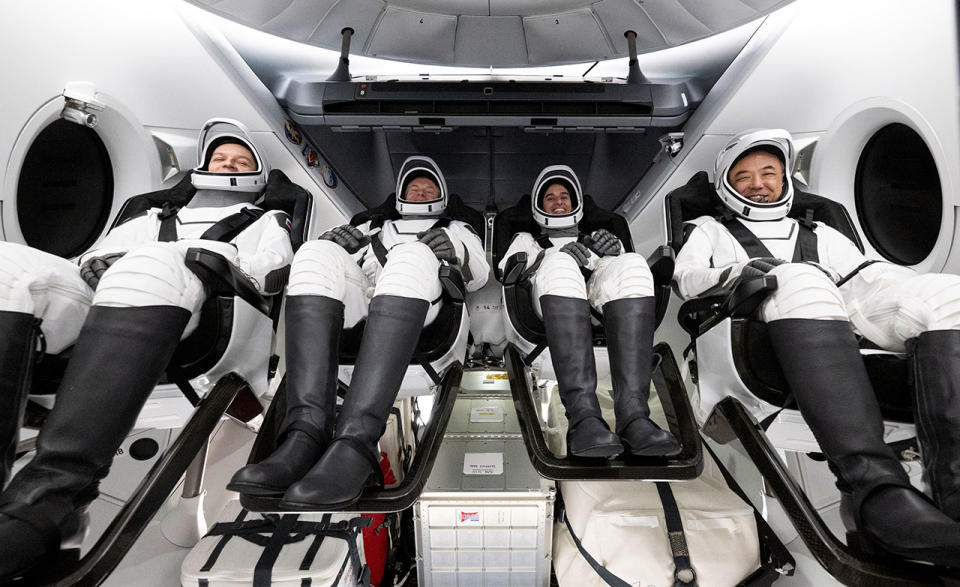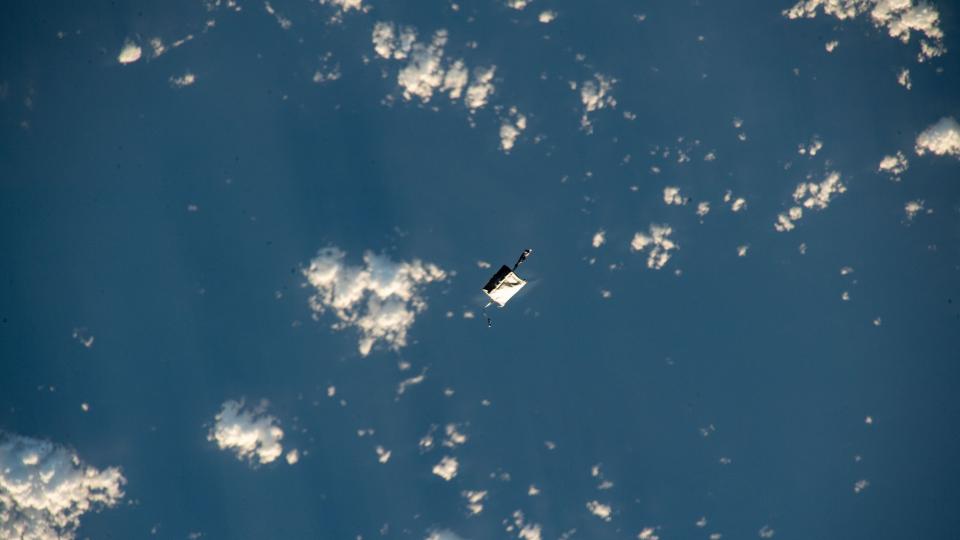Andreas Mogensen was impressed with how smooth the landing was.
The first European Space Agency (ESA) astronaut (and the first non-American) to serve as a pilot on a US commercial spacecraft, Mogensen and his SpaceX Crew-7 crewmates returned to Earth after a 197-day stay on board from the International Space Station (ISS) on March 12.
Mogensen, during his crew’s first post-flight press conference at NASA’s Johnson Space Center in Houston on Monday (March 25), likened their splashdown to “plopping into the water” of a swimming pool while wearing a life jacket.
“What struck me most was the smoothness of the landing compared to my first flight,” Mogensen said, referring to his 2015 landing on the steppe of Kazakhstan aboard a Russian Soyuz spacecraft. “The [SpaceX] Dragon lands in water, and I think that makes a big difference.”
“It was actually a very soft splash,” Mogensen said.
Related: SpaceX’s Crew-7 capsule returns 4 astronauts to Earth with a pre-dawn splashdown (video)
NASA astronaut Jasmin Moghbeli, who commanded Crew-7, agreed that the landing was soft, but then found that what came next was rougher than what others observed.
“I felt like we were really rocking back and forth,” she said, describing the end of her first spaceflight, “but then everyone I talked to said, ‘Oh, the water was glass when you landed, there there was hardly any wind’. .’ So I definitely felt a lot more movement than there was.”
That movement did not end when they were on solid ground again. The crew – including Moghbeli, Mogensen and Japan Aerospace Exploration Agency (JAXA) astronaut Satoshi Furukawa (Roscosmos cosmonaut Konstantin Borisov, the fourth member of Crew-7, missed Monday’s event, having already returned to Russia) – was subdued in physiological tests to see how they adapted to the reintroduction of gravity.
“Shortly after landing, we first try to walk with our eyes open, and then with our eyes closed,” Mogensen said. “We were all a little wobbly on our feet, but could still walk more or less in a straight line as long as our eyes were open, because they were our main source of balance after six months in space.”
“With our eyes closed, because we hadn’t used the sense of balance in our ears for six months, our brain had to rewire that sensor into the array of sensors, and that takes a while. So with our eyes closed, it was almost impossible [to walk a straight line],” he said.
“I did a nice tap dance test for that eyes-close test,” Moghbeli said, laughing.
Related: The human body in space: 6 strange facts

Fortunately, they adapted quickly, allowing them to enjoy some of the aspects of life they missed most when they were off Earth.
“I’ve missed taking a hot bath, especially in a hot spring, because water doesn’t sink and accumulates when there’s no gravity,” Furukawa said.
Similarly, Moghbeli said she missed taking hot showers, but equally longed for a greater variety of food.
“You have a set menu there and you can’t just eat whatever you want, whenever you want,” she said. ‘So my first lunch [back on Earth] was a nice roast beef sub with some Cape Cod chips, and then my first dinner was a 16 ounce prime rib with fries.
During their time together on the space station, the Crew-7 astronauts saw the arrival of seven visiting vehicles and the departure of another seven; contributed to hundreds of experiments and technology demonstrations; and Moghbeli completed the first spacewalk of her NASA career.
It was towards the end of that six-hour and 42-minute extravehicular activity (EVA) that Moghbeli made worldwide news by making her tool bag float away and get lost in space. The incident, which was minor but a challenge in itself, helped highlight another problem the astronauts encountered while in orbit.
“I found that one of the biggest challenges was trying to take a photo of a place [on Earth] that you want to shoot, and you try to time it out, you try to plan your day, and then you go to the Cupola or one of the other windows and you get ready, you get ready and then it’s just a little bit cloudy,” Mogensen said. “Even if it’s not cloudy, it might be a little foggy or the sky might not be that clear, and you won’t get a good photo.”
“So it’s actually quite a challenge when you’re trying to capture a specific target,” he said.


RELATED STORIES:
— Meet the astronauts of SpaceX’s Crew-7 mission to the ISS
– SpaceX: Facts about Elon Musk’s private space company
– International Space Station: Everything you need to know about the orbital laboratory
That’s exactly what happened to Furukawa, but it wasn’t a cloud or bad air quality that got in the way of his goal, a mountain peak southwest of Tokyo.
“We were in Junction 1, I think, having lunch or dinner, and Satoshi had been in the Cupola taking pictures. He comes in and says, ‘Well, you know, I’m very, very sorry. you, I took this picture.” And we were all like, ‘What’s going on?'”
“He had managed to take a photo of the tool bag as it was traveling over Mount Fuji. He had tried to take a photo of Mount Fuji and ended up with a photo of the tool bag,” Mogensen said, laughing.
Overall, their six months in space were very good, but some days were better than others, Moghbeli said.
“If I give an honest answer, then like anything else, if you spend six or six and a half months somewhere like we did, you will definitely have bad days,” Moghbeli said in response to a question from space. .com. “I loved being on the space station, I wouldn’t trade it for the world. It was the most incredible thing I’ve done in my life, but there were definitely days where… you realized you had a lot misses milestones and things here on earth.”
Furthermore, there were maintenance tasks that were less satisfying than giving groundbreaking demonstrations of science and technology. Still, it was worth the trip, Moghbeli said.
“In the end, I absolutely loved it. I was very sad to leave the space station,” she said.